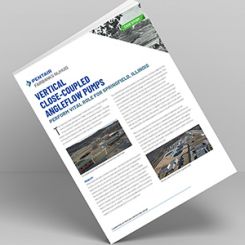Due to high specific gravity, viscosity and particle size of mining materials, centrifugal pumps are continuously challenged in mining applications. New pump technology was created to efficiently move mining materials with less downtime. The physical principle behind this new pump technology is similar to the one that enables a tornado or a waterspout to lift buildings and boats. Where a tornado utilizes a high-speed column of swirling air, this particular pump uses a column of fluid. The inventor, Harry P. Weinrib, M.D., Ph.D. in Physics, contained this energy within the confines of a pump casing.
Through different hydrodynamic principles, this new pumping technology overcomes obstacles including cavitation/NPSH loss, seal failure and clogging. Cavitation, which affects a pump's ability to deliver high percent solids while maintaining high production rates, is a constant problem in mining. Through different hydrodynamic principles, this new technology can overcome cavitation, so the pump does not suffer from loss of suction.
This phenomenon is accomplished through the synchronized eddy effect generated by the geometrically shaped rotor acting in sync with the hydrodynamic pattern of the volute. Tests show that there is no evidence of cavitation at speeds up to 2,000-rpm. The cumulative effect of this energy gives this pump a greater head than many pumps and the ability to pump more concentrated material over longer distances.
Instead of operating with an impeller, this new pump uses a patented rotor design, which can avoid wear longer than many impellers. Due to the shape of the rotor and larger tolerance between the volute, the pump endures less abusive contact with the pumping material. Wearing plates and wear rings are also not needed to regulate the efficiency, which eliminates the problem of wear rings coming into contact. When wear rings contact, it generates a high amount of friction, which produces heat that causes the rings to gall (friction weld). When galling occurs, the pump can seize.
Pumps are often subjected to severe shock loading and shaft whip from solids and system upsets, which can often cause severe seal failure and pump leakage. This new mining technology features a new seal design and negative pressure thrust upon the seal, which eliminates leakage.
Oversized obstacles in mining materials can foul the pump and cause long downtime from broken impellers, case damage, broken and bent shafts, bearing failures, warped bearing housings and broken couplings. A pump with a large tolerance between its rotor and volute is able to pump solids only 1-in less than the diameter of the discharge pipe. In many cases, the rugged cruciform rotor will break up the debris material. A chopper or a macerator pump usually is not needed with this technology as the pump is able to move the material through the discharge pipe.
Case Studies
This technology has proven itself in many mining applications, including coal tailings, drilling mud and even slurry containing steel tailings.
The coal mining industry struggles with the ability to slurry the coal tailings and transport them in a cost-efficient manner. A 6-in pump with this new technology, incorporated with a 160-hp hydraulic power unit, was able to outperform larger pumps and move a 56 percent by weight coal tailing slurry at rates of 200-yd3/hr at flow rates of 1,200-gpm. The pump was also able to pump the material with a vertical head exceeding 160-ft.
Due to the high viscosity of the drilling mud, one drilling company was having difficulties recirculating material through a 400-ft pipeline and could not exceed a flow rate over 5 barrels/min or 200- to 300-gpm. A 400-ft pipeline demonstration of this technology was set up with 43 barrels of drilling mud composed of 2.25 yards of P-gravel, 2.25 yards of sand and 16 bags of quick gel. The final specific gravity of this material was between 1.6 to 1.8. The 8-in x 6-in pump with a 250-hp motor achieved a flow rate of 22 to 24 barrels/min, or 990- to 1,080-gpm, more than four times greater than that of the existing pumps.
By incorporating the high suction power of this technology on a dredge, the system has been able to pump slurries close to a specific gravity of four, containing steel tailings. A dredge outfitted with an 8-in pump successfully completed a dredging test for the U.S. Army Corps of Engineers. The test was performed to collect information and evaluate possibilities for dredging the Indiana Harbor Ship Canal. The sediments were contaminated with volatile and semi-volatile organic compounds, plus PCBs. The pump successfully pumped the material at rates of 2,000-gpm while sustaining solid content readings of 30 to 70 percent.

